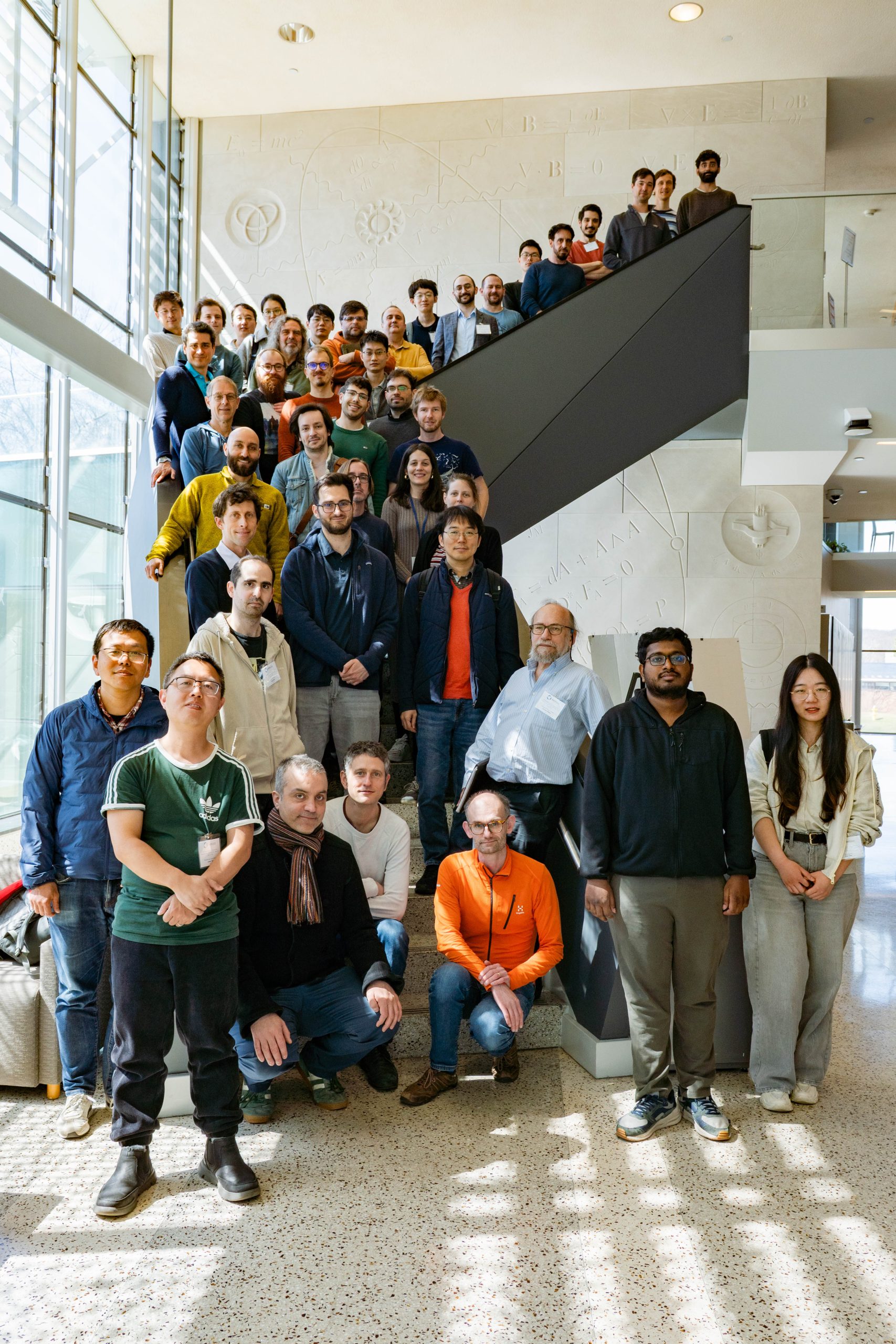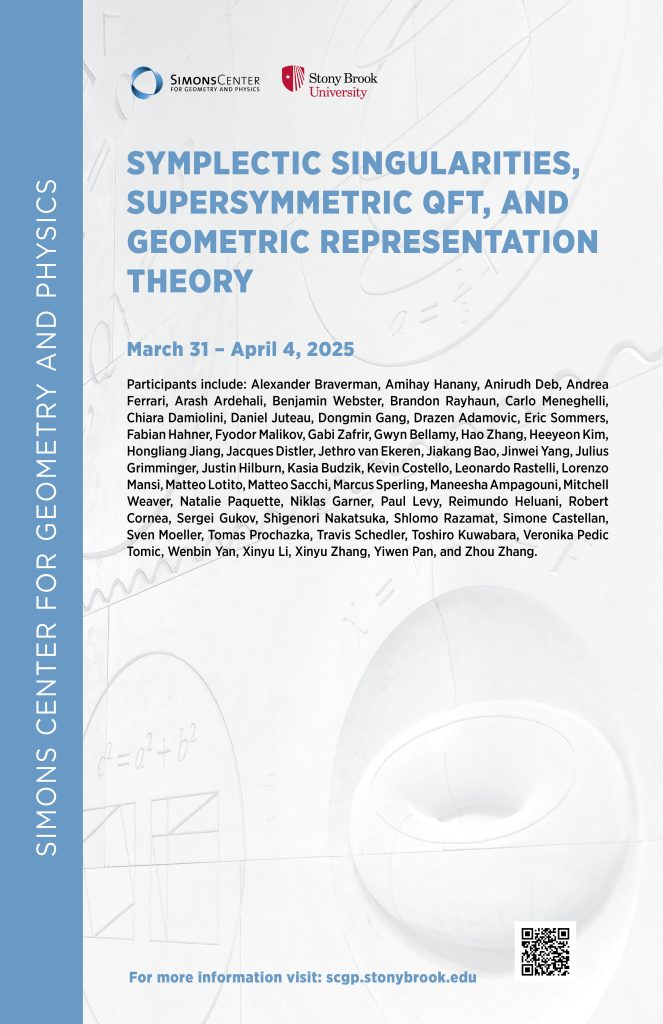Participant ListView VideosScheduleShuttle Schedule
Organized by:
- Tomoyuki Arakawa (Kyoto University)
- Christopher Beem (University of Oxford)
- Antoine Bourget (IPhT Saclay),
- Thomas Creutzig (University of Alberta)
- Julius Grimminger (University of Oxford)
- Daniel Juteau (LAMFA, Université de Picardie)
- Paul Levy (Lancaster University)
- Leonardo Rastelli (Stony Brook University)
- Brandon Rayhaun (Stony Brook University)
- Alex Weekes (University of Saskatchewan)
Supersymmetric quantum field theories (SQFTs) have been intensely researched by both physicists and mathematicians for decades. For physicists, they furnish computationally and conceptually tractable models from which one may hope to extract general lessons about quantum field theory. On the other hand, supersymmetry also often equips such theories with additional structures, both algebraic and geometric, which are mathematically rich and warrant study in their own right. This event focuses on SQFTs of diverse dimension, the geometry of their moduli spaces of vacua, and the algebras formed by their supersymmetry-preserving operators, particularly when these take the form of a vertex operator algebra. The interplay between these three subjects bears fruit; a better understanding of any one of the three enriches both of the other two.
Symplectic singularities lie at the crossroads between algebraic geometry and representation theory, while from the physical perspective they arise as moduli spaces for supersymmetric quantum field theories. As such, they can be studied using tools from string theories and branes, in addition to tools from algebraic geometry, sheaf theory, and beyond. Notable examples include slices to nilpotent orbit closures and their covers, symplectic quotient singularities, slices in the affine Grassmannian, quiver varieties, and associated varieties for vertex operator algebras. In the last few years, the rigorous construction of Coulomb branches, motivated by 3d gauge theories, has opened new avenues of study, including surprising connections between singularities investigated in the context of classical integrable systems of Calogero-Moser type and moduli spaces of super(-conformal) quantum field theories. This workshop will bring together mathematicians and physicists, with symplectic singularities as a focal point, to push further these connections and aim at a global understanding, with implications for the classification of SQFTs.
This workshop is associated with the program: Supersymmetric Quantum Field Theories, Vertex Operator Algebras, and Geometry – March 17th – April 18th, 2025.

Talk Schedule
| Time | Title | Speaker | Location |
| 8:30am | Breakfast | N/A | SCGP Cafe |
| 9:30am | 3d TFTs from 4d N=2 BPS particles | Heeyeon Kim | SCGP 102 |
| 10:30am | Coffee Break | N/A | SCGP Cafe |
| 11:00am | Families VOAs from BPS Particles | Jaewon Song | SCGP 102 |
| 12:00pm | Lunch | N/A | SCGP Cafe |
| 2:30pm | Geometry of Coulomb Branches | Ben Webster | SCGP 102 |
| 3:30pm | Tea Time | N/A | SCGP Cafe |
| 4:00pm | Minimal degenerations for quiver varieties | Gwyn Bellamy | SCGP 102 |
| Time | Title | Speaker | Location |
| 8:30am | Breakfast | N/A | SCGP Cafe |
| 9:30am | Quasi-lisse hypertoric VOAs, free fields, (and holography) | Andrea Ferrari | SCGP 102 |
| 10:30am | Coffee Break | N/A | SCGP Cafe |
| 11:00am | Generalized symmetries and the dimensional reduction of 6d so SCFTs | Gabi Zafrir | SCGP 102 |
| 12:00pm | Group Photo | N/A | SCGP Lobby |
| 12:00pm | Lunch | N/A | SCGP Cafe |
| 2:30pm | Chiral Quantisation of Symplectic Resolutions: The Quiver Case | Sven Möller | SCGP 102 |
| 3:30pm | Tea Time | N/A | SCGP Cafe |
| 4:00pm | On the representation theory of affine VOAs and W-algebras via inverse QHR | Dražen Adamović | SCGP 102 |
| Time | Title | Speaker | Location |
| 8:30am | Breakfast | N/A | SCGP Cafe |
| 9:30am | From vertex algebras to scattering amplitudes | Kevin Costello | SCGP 102 |
| 10:30am | Coffee Break | N/A | SCGP Cafe |
| 11:00am | Geometry of log-VOAs and braiding of Verma modules for U_q (sl_N) | Sergei Gukov | SCGP 102 |
| 12:00pm | Lunch | N/A | SCGP Cafe |
| 3:30pm | Tea Time | N/A | SCGP Cafe |
| 6:00pm | Banquet Dinner | N/A | SCGP Cafe |
| Time | Title | Speaker | Location |
| 8:30am | Breakfast | N/A | SCGP Cafe |
| 9:30am | TBD | Amihay Hanany | SCGP 102 |
| 10:30am | Coffee Break | N/A | SCGP Cafe |
| 11:00am | Generalized lattices, conformal manifolds, and symmetries | Shlomo Razamat | SCGP 102 |
| 12:00pm | Lunch | N/A | SCGP Cafe |
| 2:30pm | Hikita conjecture for Slodowy slices and nilpotent orbit covers | Dmytro Matvieievskyi | SCGP 102 |
| 3:30pm | Tea Time | N/A | SCGP Cafe |
| 4:00pm | Koszul duality in Relative Langlands duality/S-duality | Alexander Braverman | SCGP 102 |
| Time | Title | Speaker | Location |
| 8:30am | Breakfast | N/A | SCGP Cafe |
| 9:30am | The (lack of) progress on chiral homology and extensions of vertex algebra modules</td | Heluani Reimundo | SCGP 102 |
| 10:30am | Coffee Break | N/A | SCGP Cafe |
| 11:00am | Higher Products of the Vertex Operator Algebra of 4d N = 2 SCFTs | Mitch Weaver | SCGP 102 |
| 12:00pm | Lunch | N/A | SCGP Cafe |
*Workshop ends after lunch


